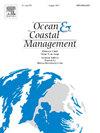Estuarine morphodynamics regime shift caused by catchment reservoir: Illustration from the Minjiang River Estuary
IF 4.8
2区 环境科学与生态学
Q1 OCEANOGRAPHY
引用次数: 0
Abstract
Human activities, particularly reservoir construction, have become a focal point in contemporary earth science research due to their profound impacts on flow-sediment-ecology systems of catchment. While some investigations have examined reservoir-induced alterations in fluvial-estuarine sedimentation patterns, the feedback mechanisms between morphological changes and tidal dynamics remain inadequately explored. This research focuses on the Minjiang River estuary, a macrotidal system in southeastern China, characterized as a medium-scale catchment (length: 562 km; drainage area: 60,000 km2). Employing an integrated approach combining field hydrographic measurements, multi-temporal digital elevation models, and Mike21 simulations, this study quantifies the decadal-scale interplay between anthropogenic-driven geomorphic evolution and tidal system adjustments over a 40-year period (1984–2022). The analysis reveals that reservoir operations and river sand mining have transformed the estuarine sedimentary regime from net deposition (0.4 cm/year, 1984–2005) to accelerated erosion (−2.6 cm/year, 2005–2022). This geomorphic transition has triggered significant hydrodynamic responses. During the deposition-dominated phase (1984–2005), sediment accumulation resulted in a progressive decline of 1.5 cm in the mean tidal levels and a 6.5 cm/s reduction in flow velocities. Conversely, the subsequent erosional period (2005–2022) saw a 2.2 cm rise in tidal levels accompanied by a 9.3 cm/s acceleration in flow velocities. The flow and sediment flux during flood and ebb periods in estuarine branches such as North Branch increased by 53 % and 57 %, respectively. Furthermore, the bed dunes in Maiwei and North Branch increased by 0.3m (13 %) and 0.1 m (8 %), respectively. This research establishes a fundamental principle of sediment dynamics: depositional processes attenuate tidal energy while erosional regimes enhance hydrodynamics. These findings provide critical insights into the cascading effects of human activities at the catchment scale on coastal hydro-morphological systems, offering a scientific framework for sustainable estuarine management under increasing anthropogenic pressures.
集水区水库引起的河口形态动力学变化——以岷江河口为例
人类活动,特别是水库建设,由于其对流域流-沙-生态系统的深刻影响,已成为当代地球科学研究的热点。虽然一些调查已经检查了水库引起的河流河口沉积模式的变化,但形态变化和潮汐动力学之间的反馈机制仍然没有得到充分的探索。闽江河口是中国东南部的一个大潮系统,其特征是中等尺度集水区(长度:562 km;流域面积:60000平方公里)。采用现场水文测量、多时段数字高程模型和Mike21模拟相结合的综合方法,本研究量化了40年(1984-2022)期间人类驱动的地貌演化与潮汐系统调整之间的十年尺度相互作用。分析表明,水库作业和河道采砂使河口沉积状态从净沉积(0.4 cm/年,1984-2005)转变为加速侵蚀(- 2.6 cm/年,2005-2022)。这种地貌转变引发了显著的水动力响应。在沉积为主阶段(1984-2005年),泥沙淤积导致平均潮位逐渐下降1.5 cm,流速下降6.5 cm/s。相反,随后的侵蚀期(2005-2022年)潮汐水位上升了2.2厘米,流速加速了9.3厘米/秒。北支等河口支流在汛期和退潮期的流量和沙通量分别增加了53%和57%。麦尾和北支床状沙丘分别增加了0.3m(13%)和0.1 m(8%)。本研究确立了沉积动力学的基本原理:沉积过程减弱潮汐能,而侵蚀机制增强水动力。这些发现为流域尺度上人类活动对沿海水文形态系统的级联效应提供了重要见解,为日益增加的人为压力下的可持续河口管理提供了科学框架。
本文章由计算机程序翻译,如有差异,请以英文原文为准。
求助全文
约1分钟内获得全文
求助全文
来源期刊

Ocean & Coastal Management
环境科学-海洋学
CiteScore
8.50
自引率
15.20%
发文量
321
审稿时长
60 days
期刊介绍:
Ocean & Coastal Management is the leading international journal dedicated to the study of all aspects of ocean and coastal management from the global to local levels.
We publish rigorously peer-reviewed manuscripts from all disciplines, and inter-/trans-disciplinary and co-designed research, but all submissions must make clear the relevance to management and/or governance issues relevant to the sustainable development and conservation of oceans and coasts.
Comparative studies (from sub-national to trans-national cases, and other management / policy arenas) are encouraged, as are studies that critically assess current management practices and governance approaches. Submissions involving robust analysis, development of theory, and improvement of management practice are especially welcome.
 求助内容:
求助内容: 应助结果提醒方式:
应助结果提醒方式:


